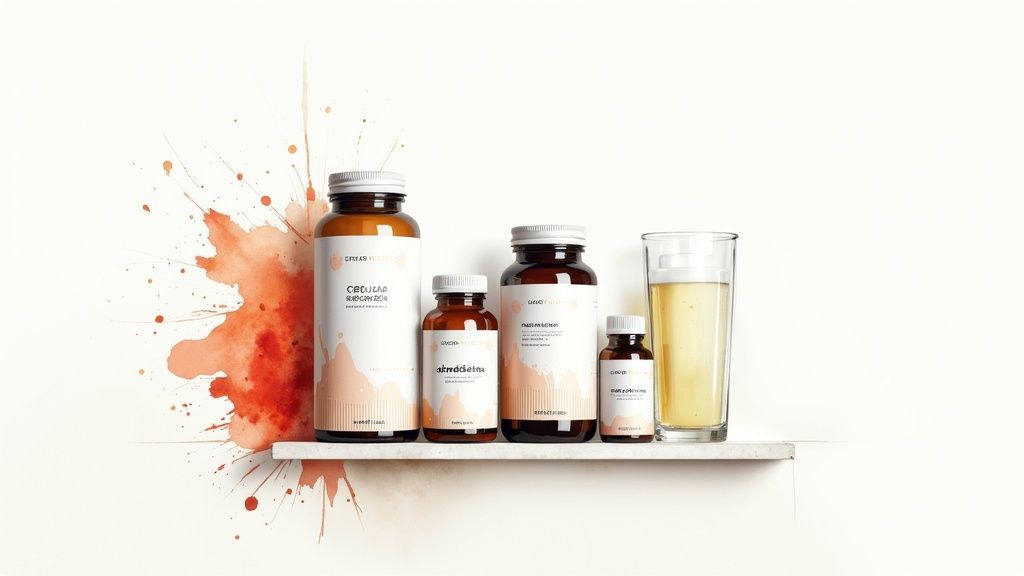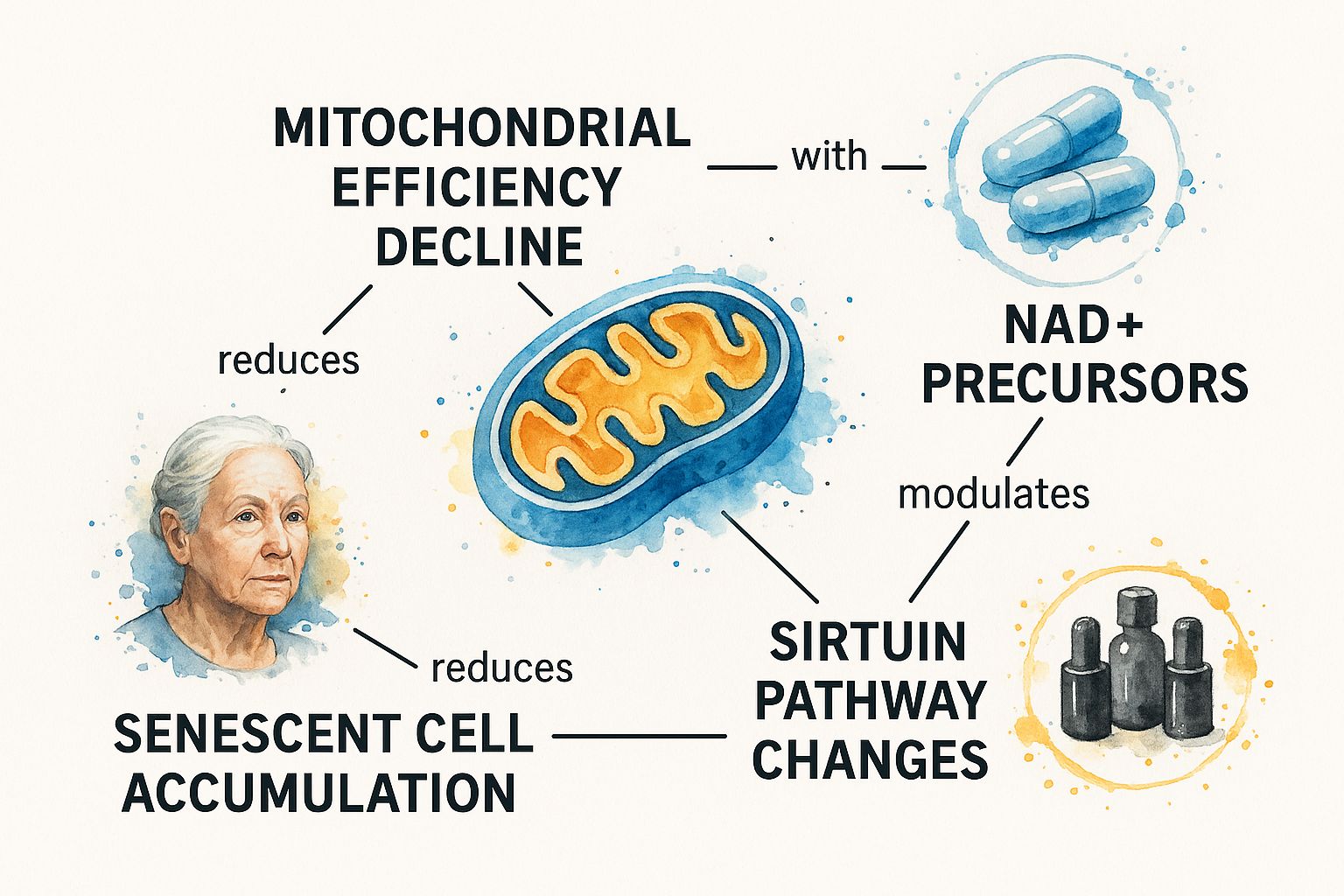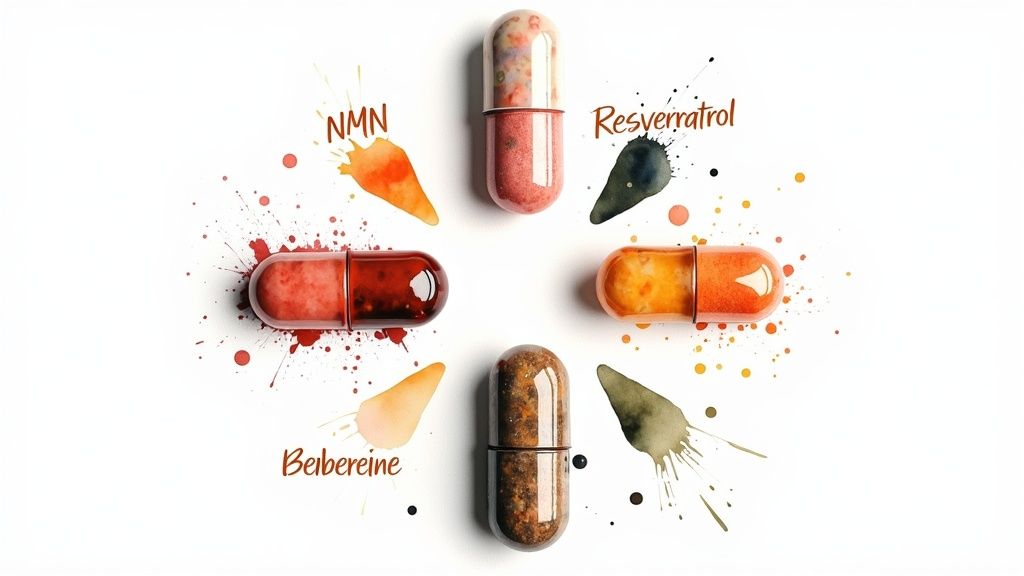The truth is, the best longevity supplements aren't about magic; they're about biology. The most effective ones target the fundamental processes that drive ageing, like the slow decline of cellular energy or persistent inflammation. We’re talking about categories like NAD+ Precursors (such as NMN), Senolytics (like fisetin), and Sirtuin Activators (resveratrol), each tackling the challenge of ageing from a unique angle.
Your Actionable Guide to Longevity Supplements

Stepping into a health food shop or scrolling through online stores can be a dizzying experience. Shelves are stacked with bottles, all promising to wind back the clock. It's easy to feel lost. This guide is here to cut through that clutter and give you a straightforward, practical map to start navigating your options.
First things first, let's define our goal. This isn't about some mythical "anti-ageing" pill. The real objective is to extend your healthspan—the portion of your life you spend in good health, full of energy and free from chronic disease. The actionable takeaway is simple but powerful: we are aiming to add more life to our years, not just more years to our life.
Understanding the Core Categories
To make informed choices, it helps to think of longevity supplements in terms of their core mission inside your body. Each group targets a different hallmark of ageing, a bit like how a team of specialists would work together on different aspects of your health.
Here’s an actionable overview of the main categories to get you started.
Quick Overview of Top Longevity Supplement Categories
This table gives a snapshot of the primary categories of longevity supplements, their core functions, and common examples you might find in the UK.
| Supplement Category | Primary Mechanism | Common Examples |
|---|---|---|
| NAD+ Precursors | These act like power banks for your cells, boosting NAD+, a vital coenzyme for energy that declines with age. | NMN, Nicotinamide Riboside (NR) |
| Sirtuin Activators | Think of these as managers for your cellular repair crew. They activate proteins that help with DNA repair and inflammation. | Resveratrol, Pterostilbene |
| Senolytics | These are the 'clean-up crew', helping the body clear out old, malfunctioning 'zombie' cells that cause damage. | Fisetin, Quercetin, Piperlongumine |
| Anti-Inflammatories | These are your body's protectors, defending cells from the damage caused by chronic inflammation and oxidative stress. | Curcumin, Omega-3 Fatty Acids |
By using this framework, you're no longer just looking at a jumble of ingredient names. You can start to understand the why behind each supplement.
The smartest way to think about supplementation isn't a hunt for one miracle pill. It's about strategically supporting your body's innate systems for repair, energy, and maintenance. You're building resilience from the cell up.
Once you grasp these fundamental categories, you're in a far better position to make choices that are right for you. This guide will build on that foundation, linking these concepts to the real science of ageing and, most importantly, to your personal health journey. It’s about giving you the knowledge to move forward with confidence.
Understanding the Science of Healthy Ageing
Before you can choose the best longevity supplements, you need a clear picture of what’s actually happening inside our bodies as the years go by. You don’t need a PhD in biology to grasp this; the core ideas are surprisingly straightforward. Ageing isn't one big event, but rather a series of small, gradual shifts at the cellular level.
Think of your body as a complex, bustling city. For the city to run smoothly, everything from its power stations to its rubbish collection services must work perfectly. As time passes, some of these systems naturally start to lose their edge, and that's where the science of healthy ageing really focuses its attention.
The Cellular Energy Crisis
At the very heart of it all is energy production. Every single one of your cells is packed with thousands of tiny power plants called mitochondria. Their job is simple but vital: turn food and oxygen into the energy that powers every single thing you do, from thinking a thought to lifting a finger.
As we get older, these little power plants can become less efficient. This slowdown is largely because of a dip in a critical molecule known as Nicotinamide Adenine Dinucleotide (NAD+). NAD+ is like the fuel truck that keeps the power plants running. When there's less NAD+ around, the mitochondria can't generate energy as well, which can lead to that familiar feeling of slowing down. It’s like a city-wide power grid struggling to meet demand.
This is precisely why supplements like NAD+ precursors have become so popular. They aim to give your body the raw materials it needs to top up its NAD+ reserves, essentially helping to get those cellular power plants back online.
The Problem with 'Zombie' Cells
Another major piece of the ageing puzzle is the build-up of what scientists call senescent cells. A better, and frankly more accurate, name for them is 'zombie cells'. These are cells that have stopped dividing but stubbornly refuse to die off. Instead, they just hang around in our tissues, leaking a steady stream of inflammatory chemicals.
Imagine a couple of factory workers who have stopped doing their jobs but insist on loitering on the factory floor, distracting their colleagues and gumming up the works. At first, a few zombie cells aren't a huge problem. But as more and more of them accumulate, their constant inflammatory chatter starts to disrupt the healthy cells nearby.
This accumulation of senescent cells is a core driver of age-related inflammation and tissue decline. Effectively managing them is a key strategy for promoting a longer healthspan.
This has spurred the development of senolytics—compounds that are specifically designed to help the body clear out these zombie cells. By selectively pruning them away, senolytics aim to reduce that inflammatory background noise, giving healthy cells the space to function properly.
This infographic shows how specific biological changes are targeted by different types of longevity supplements.
The visualisation clearly links core ageing mechanisms like mitochondrial decline and senescent cell build-up to actionable supplement categories that address them directly.
Activating Your Cellular Guardians
Finally, let's talk about our body's built-in repair crew. We have a crucial family of proteins called sirtuins, which you can think of as the cell's diligent maintenance managers. They are in charge of everything from DNA repair and inflammation control to keeping our metabolism in check.
There's a catch, though. Sirtuins need NAD+ to get their work done. So, as our NAD+ levels fall with age, these guardians don't have enough energy to do their jobs properly. It creates a domino effect: less NAD+ leads to less sirtuin activity, which in turn means slower repairs and a general drop in resilience.
Certain compounds, often called sirtuin activators, are thought to give these proteins a direct nudge, encouraging them to stay on the job even when NAD+ is less abundant. It's a way of keeping the body's natural defence systems switched on. Of course, maintaining a healthy weight and an efficient metabolism is also fundamental to healthy ageing. You can explore the science-backed green tea weight loss benefits to see how natural compounds can support these crucial metabolic pathways.
By getting to grips with these three core ideas—cellular energy, zombie cells, and guardian proteins—you're no longer just a passive consumer. You're making an informed choice to support the very biological processes that dictate how well you age. This knowledge is your best tool for seeing past the marketing noise and focusing on what truly counts for your long-term health.
Exploring the Top Tiers of Longevity Supplements

Now that we've covered the science behind ageing, we can get down to the practical side of things. It's time to look at the specific compounds making a real name for themselves in the world of healthy ageing.
Instead of just giving you a long, confusing list, I'm going to break these supplements down by what they actually do. Think of them like specialised tools in a toolkit. You wouldn't use a hammer to turn a screw; in the same way, you choose longevity supplements based on the specific biological system you want to support. Let’s dive into the most well-researched categories out there.
NAD+ Precursors: The Cellular Fuel Boosters
Right at the top of the list are NAD+ precursors, with Nicotinamide Mononucleotide (NMN) and Nicotinamide Riboside (NR) leading the charge. As we touched on earlier, NAD+ is a vital coenzyme—it’s essentially the lifeblood of our cells' energy production. The problem is, our natural levels can drop by as much as 50% between the ages of 40 and 60, affecting everything from our metabolism to our body's ability to repair DNA.
NMN and NR are simply the raw materials your body needs to make more NAD+. Taking them is like refuelling the tanker that supplies all the power stations in your cellular city. By topping up your NAD+ levels, you're giving your cells the juice they need to do their jobs properly. To get a deeper understanding of this, you can explore the many potential NMN supplement benefits in our detailed guide.
Sirtuin Activators: The Longevity Gene Managers
Closely tied to NAD+ are the sirtuins, a family of proteins often called our "longevity genes." These guys are like the maintenance managers for your cells. They oversee DNA repair, keep inflammation in check, and make sure your metabolism is running smoothly. But there’s a catch: they need NAD+ to get to work.
This is where sirtuin activators like resveratrol come in. Resveratrol is a natural compound you find in things like the skin of red grapes and berries. It’s thought to give sirtuins a direct kickstart, encouraging them to stay on the job even when NAD+ levels might not be at their peak.
A popular strategy is to combine an NAD+ precursor with a sirtuin activator. The thinking is simple: you’re not only providing the fuel (NAD+) but also pressing the accelerator on the engine that uses it (sirtuins). This creates a powerful one-two punch for cellular health.
This approach tackles two sides of the same coin, aiming for a much more comprehensive impact on cellular resilience.
mTOR Modulators: Balancing Growth and Repair
Another key pathway in the body is mTOR (mammalian target of rapamycin). Picture mTOR as a master switch. It tells your cells when to grow and divide, and when it’s time to conserve energy and do some housekeeping. When we're young, mTOR is firing on all cylinders to support growth, but if it stays constantly switched on in adulthood, it can actually speed up ageing.
Certain supplements, known as mTOR modulators, help to gently dial this pathway down. Berberine, a compound extracted from several plants, is one of the most studied. By lightly tapping the brakes on mTOR, berberine encourages the body to shift into a state of cellular clean-up and repair called autophagy. It's a crucial balancing act for long-term health.
The goal isn't to shut mTOR off completely, but rather to promote a healthy cycle of growth and renewal—a true cornerstone of ageing well.
Senolytics: The Cellular Housekeepers
Finally, we have the cellular clean-up crew: senolytics. As we discussed, senescent or 'zombie' cells build up as we get older, creating a constant, low-grade inflammatory fog that damages healthy tissue around them. Senolytics are fascinating compounds that help the body find and clear out these troublemakers.
Two of the most well-known natural senolytics are quercetin and fisetin, both of which are found in lots of fruits and vegetables.
- Quercetin: Found in apples, onions, and capers, it's known for its strong antioxidant and anti-inflammatory effects.
- Fisetin: Plentiful in strawberries, it has shown incredible promise in research for its knack for selectively targeting and eliminating senescent cells.
The approach with senolytics is usually a bit different. Instead of a daily pill, many people take them in higher doses for just a few days at a time, followed by a break of several weeks. This "hit-and-run" method is designed to periodically flush out zombie cells, lifting the inflammatory burden from your body.
By understanding these four key tiers, you can start to see how a smart, strategic supplement plan is built. Each category offers a distinct way to support the biological pathways that dictate how well you age, empowering you to make choices that truly line up with your healthspan goals.
How to Choose the Right Supplements for Your Goals
Knowing the different types of longevity supplements is a great start. But the real game-changer is turning that knowledge into a smart, personal action plan. Generic advice only gets you so far; what works brilliantly for one person might do very little for another. Real progress begins when you match your supplement choices to your unique health goals.
The question to ask isn't just "what are the best longevity supplements?" It's "what are the best longevity supplements for me?" The answer lies in what you're trying to achieve. Are you aiming to tackle persistent fatigue, sharpen your focus, or get your metabolic health in order? Each goal points to different biological pathways and, naturally, a different supplement strategy.
For instance, if you're constantly feeling drained, you might look into NAD+ precursors to give your cellular energy production a boost. Someone else focused on balancing their metabolism might find mTOR modulators like berberine more relevant. Always start with your "why" – it's the simplest way to cut through the noise and narrow down your options.
Use Data to Drive Your Decisions
When it comes to your health, guesswork just won't cut it. The most reliable way to create a personal plan is to use cold, hard data about your own body. This is where simple blood tests, and the biomarkers they reveal, become your most powerful tool. Instead of wondering if you have a deficiency, you can know for sure.
These tests can highlight critical details about your vitamin levels, inflammation markers like hs-CRP, and key indicators of your metabolic health. Seeing these numbers in black and white shifts your approach from guesswork to a clear-headed strategy. You can learn more about how this works in our guide to using a blood test for vitamin and mineral deficiency.
A data-driven approach takes the ambiguity out of supplementation. When you know your baseline biomarker levels, you can make targeted choices to address specific needs and actually track your progress over time.
This method lets you see what’s working and what isn’t, allowing you to fine-tune your routine for the best possible results. It’s the difference between trying to find your way in the dark and navigating with a map and a compass.
Vet for Quality and Purity
Once you've got a shortlist of supplements that match your goals and are backed by your own data, the final piece of the puzzle is checking their quality. The supplement market can be a bit of a wild west, and the difference in purity and potency from one brand to the next is staggering.
Look for these non-negotiable signs of a high-quality product:
- Third-Party Testing: This is essential. Look for seals from independent bodies like NSF International or USP. It’s your proof that the product contains what the label claims, in the right amounts, and is free from nasty contaminants.
- GMP Certification: Good Manufacturing Practices (GMP) certification ensures the supplement was made in a clean, controlled, and consistent facility.
- Clear Dosages: The label must clearly state the amount of the active ingredient per serving. This allows you to follow dosage guidelines that are based on solid research.
This demand for quality is becoming much more common. Here in the UK, we're seeing a clear shift towards proactive health management, with people increasingly choosing products that are backed by proper quality assurance. In fact, the UK dietary supplements market is projected to hit £8.19 billion by 2034, a surge driven by informed consumers who want options they can trust. You can read more about the rise of longevity supplements in the UK on Vocal.media.
And finally, a crucial last step: always have a chat with your doctor or another healthcare professional before starting anything new. They can look at your health history and blood work to help you put together a plan that's safe, effective, and truly designed for you.
Integrating Supplements with a Pro-Longevity Lifestyle

While the science behind the best longevity supplements is genuinely exciting, it’s vital to see the bigger picture. These compounds are powerful allies, not magical shortcuts. They work best when they amplify a lifestyle already pointed towards healthy ageing. Think of them as a specialist tool in your kit—incredibly effective for a specific job, but not a replacement for laying the groundwork.
The real aim is to create a powerful synergy where your daily habits and your supplement routine work together, each making the other more effective. This integrated approach means you’re supporting your body’s health from every possible angle, building a resilient system that can function at its best for longer.
The Four Pillars of Healthy Ageing
Four key pillars form the bedrock of any solid longevity plan: diet, exercise, sleep, and stress management. When you get these right, you create the ideal internal environment for supplements to do their job properly. Skipping them is like trying to build a strong house on a shaky foundation.
Take exercise, for example. It does far more than just build muscle. A brisk walk or a bit of strength training naturally stimulates many of the same cellular pathways that NAD+ precursors target. By doing both, you’re essentially flipping the same longevity switch from two different directions, creating a much bigger impact than either could on its own.
Creating Synergistic Effects
This idea of synergy applies to everything. A diet packed with anti-inflammatory whole foods provides antioxidants and phytonutrients that work hand-in-glove with supplements like curcumin to keep inflammation under control. Likewise, deep, quality sleep is when your body gets down to its most important repair work—a job that’s supported and enhanced by compounds that help with cellular clean-up.
Supplements don't replace healthy habits; they enhance them. The most potent longevity strategy is one where your lifestyle choices and your supplement regimen are pulling in the same direction, creating a compounding effect over time.
This holistic view is absolutely crucial. Chronic stress, for instance, floods your system with cortisol, a hormone that can speed up ageing and undo the very benefits you're trying to achieve. That's why a genuine pro-longevity lifestyle must include natural strategies for stress reduction.
To build a truly robust foundation, have a look at our guide covering the top tips on hydration, nutrition, exercise, and sleep. By making these pillars a non-negotiable part of your daily routine, you ensure that every supplement you take is landing on fertile ground, ready to deliver its full potential.
Got Questions About Longevity Supplements? Let's Get Them Answered.
Stepping into the world of longevity supplements naturally brings up a lot of questions. It's a complex area, so let's wrap up by tackling some of the most common things people ask. My goal here is to give you clear, straightforward answers so you can feel confident about the path you're on.
Can I Mix and Match Different Supplements?
Absolutely. In fact, it's quite common. People in this space often talk about "stacking" supplements to get a combined effect.
A classic example is taking an NAD+ booster like NMN with a sirtuin activator like resveratrol. Think of it this way: the NMN provides the fuel (NAD+) for your cellular machinery, while the resveratrol essentially steps on the accelerator for the sirtuin repair crews. The idea is that they work better together.
The key, though, is to go slow. Never start a handful of new supplements all at once. Introduce just one at a time and give your body a few weeks to adjust before considering another. And, of course, run any potential stack by your doctor first to make sure it's a safe and sensible combination for you.
How Long Until I Actually Notice Anything?
This is where patience really is a virtue. Longevity supplements are playing the long game, working deep at a cellular level. You’re not going to feel an overnight transformation like you would from a painkiller.
Most people start to notice subtle shifts—maybe a bit more sustained energy, sharper thinking, or quicker recovery from exercise—after about 8 to 12 weeks of consistent daily use.
Remember, the best longevity supplements aren’t about a quick fix. They’re a long-term investment in your cellular health. Real progress is measured over months, not days, and the best proof often comes from seeing your biomarkers improve in a follow-up blood test.
Are These Supplements Safe for Everyone?
Not necessarily. While many of these compounds are found in nature and generally have a good safety profile, they aren't a one-size-fits-all solution. If you are pregnant, breastfeeding, or managing a pre-existing medical condition, you need to be particularly cautious.
It's also really important to know that some supplements can interfere with prescription medications. This is precisely why having a chat with your doctor before you start is non-negotiable. They can look at your full health picture and help you put together a plan that’s not just effective, but—most importantly—safe.
Take control of your health journey with Lola's precise, at-home blood testing services. Move beyond guesswork and get a data-driven plan tailored to your unique biology. Discover your personalised health insights today.
